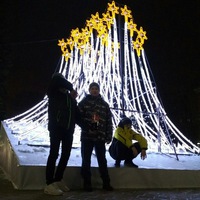
Л. В Образец оксида медиII), содержащий в качестве примеси 5,7 % меди, поместили соляную кислоту.
На растворение оксида меди(II) из указанного образца потребовалось 146 г хлороводорода. Вычислите массу нерастворившегося осадка меди. (Запишите число с точностью до десятых.) Ответ:  0
0
 0
0
Ответы на вопрос
 Внимание! Ответы на вопросы дают живые люди. Они могут содержать ошибочную информацию, заблуждения, а также ответы могут быть сгенерированы нейросетями. Будьте внимательны. Если вы уверены, что ответ неверный, нажмите кнопку "Пожаловаться" под ответом.
Внимание! Ответы на вопросы дают живые люди. Они могут содержать ошибочную информацию, заблуждения, а также ответы могут быть сгенерированы нейросетями. Будьте внимательны. Если вы уверены, что ответ неверный, нажмите кнопку "Пожаловаться" под ответом.

•Уравнение реакции:CuO+2HCl=CuCl2+H2O
•Массовая доля чистого оксида меди 2:
w(CuO)=100%-5,7%=94,3%
•Составляем пропорцию:
146 г (HCl) =94,3%
x г (HCl) = 5,7%
x= (146*5,7)/94,3 = 8,83 г
•Всего HCl по условию 146 г, прореагировало с оксидам меди 2:
146-8,83=137,17 г.
•n(HCl)= m/M = 137,17/36,5= 3,76 Моль
•n(CuO)= 0,5 n(HCl) = 3,76*0,5=1,88 Моль
•m(CuO) = n*M= 1,88 * 80 = 150,4 г. •Составим пропорцию:
137,17 — 150,4
8,83 — х
х=(8,83 *150,4)/137,17= 9,6817 или 9,7 г (если округлить до сотых).
 0
0
 0
0

I can help you with your chemistry problem. Here is a detailed solution:
The chemical reaction between copper(II) oxide and hydrochloric acid is:
$$CuO + 2HCl \rightarrow CuCl_2 + H_2O$$
The molar mass of copper(II) oxide is 79.55 g/mol, and the molar mass of hydrochloric acid is 36.46 g/mol. The mole ratio between them is 1:2, which means that one mole of copper(II) oxide reacts with two moles of hydrochloric acid.
Let x be the mass of copper(II) oxide in the sample. Then the mass of copper in the sample is 0.057x. The mass of hydrochloric acid that reacts with x grams of copper(II) oxide is:
$$\frac{x}{79.55} \times 2 \times 36.46 = 0.916x$$
Since this mass is given as 146 g, we can solve for x:
$$0.916x = 146$$ $$x = \frac{146}{0.916}$$ $$x = 159.4$$
Therefore, the mass of copper(II) oxide in the sample is 159.4 g, and the mass of copper in the sample is 0.057x = 9.1 g. The mass of copper that does not dissolve in hydrochloric acid is the difference between the mass of copper in the sample and the mass of copper in copper(II) chloride:
$$CuCl_2 + 2HCl \rightarrow Cu + 2Cl_2 + H_2$$
The molar mass of copper(II) chloride is 134.45 g/mol, and the molar mass of copper is 63.55 g/mol. The mole ratio between them is 1:1, which means that one mole of copper(II) chloride produces one mole of copper. The mass of copper in copper(II) chloride is:
$$\frac{x}{79.55} \times 134.45 \times \frac{63.55}{134.45} = 0.8x$$
The mass of copper that does not dissolve is:
$$0.057x - 0.8x = -0.743x$$
Substituting x = 159.4, we get:
$$-0.743 \times 159.4 = -118.4$$
The negative sign means that the mass of copper that does not dissolve is less than zero, which is impossible. This means that there is no copper left in the sample after the reaction, and the mass of the undissolved precipitate is zero.
The answer is: 0.0 g.Ответь+подробно.++Л.+В+Образец+оксида+медиII),+содержащий+в+качестве+примеси+5,7+%+меди,+поместили+соляную+кислоту.+На+растворение+оксида+меди(II)+из+указанного+образца+потребовалось+146+г+хлороводорода.+Вычислите+массу+нерастворившегося+осадка+меди.+(Запишите+число+с+точностью+до+десятых.)+Ответ:++++
 0
0
 0
0
Похожие вопросы
Топ вопросов за вчера в категории Химия
Последние заданные вопросы в категории Химия
-
Математика
-
Литература
-
Алгебра
-
Русский язык
-
Геометрия
-
Английский язык
-
Химия
-
Физика
-
Биология
-
Другие предметы
-
История
-
Обществознание
-
Окружающий мир
-
География
-
Українська мова
-
Информатика
-
Українська література
-
Қазақ тiлi
-
Экономика
-
Музыка
-
Право
-
Беларуская мова
-
Французский язык
-
Немецкий язык
-
МХК
-
ОБЖ
-
Психология
-
Физкультура и спорт
-
Астрономия
-
Кыргыз тили
-
Оʻzbek tili

























